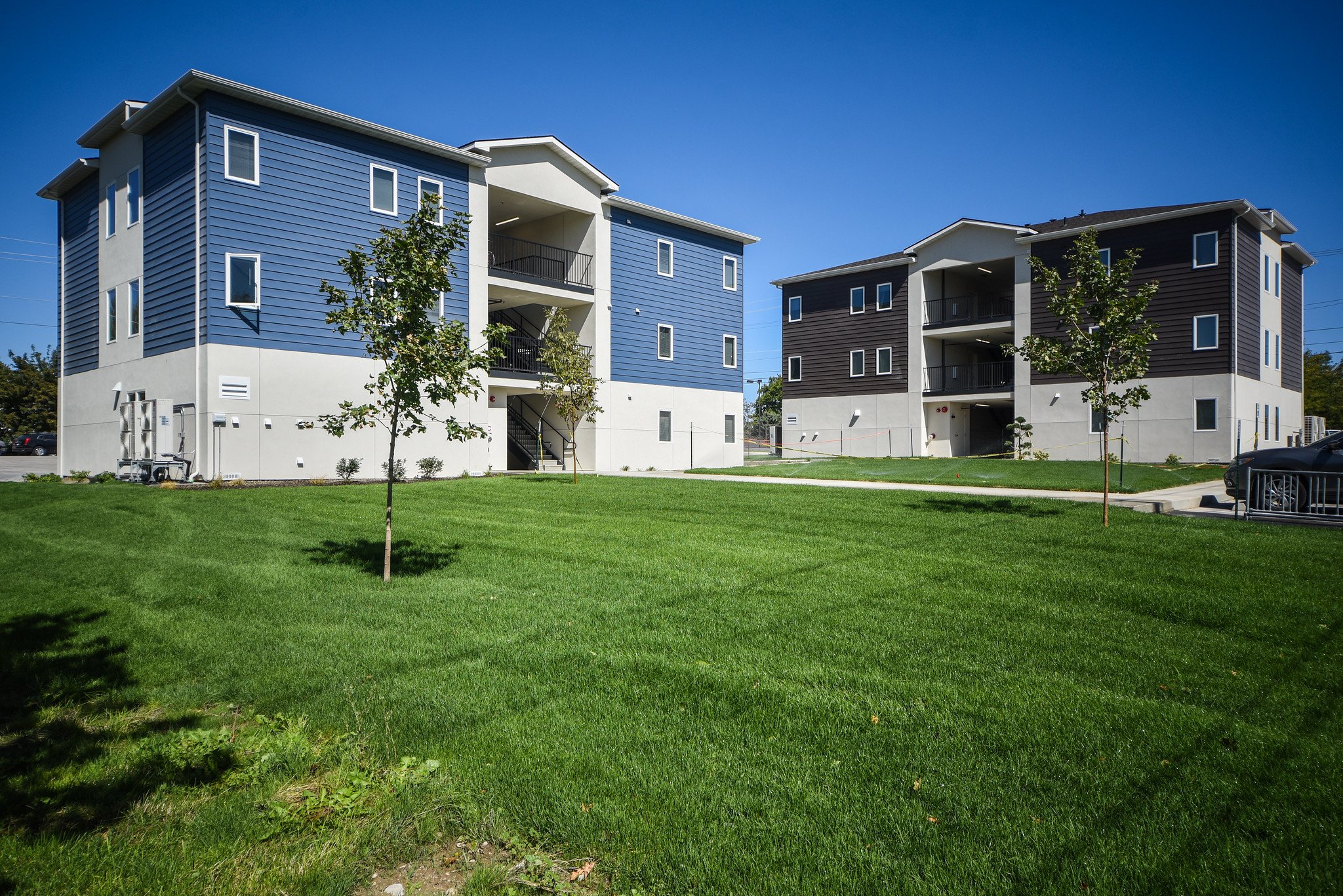You have /5 articles left.
Sign up for a free account or log in.

An artistic rendering of Fisk University’s planned student living complex built from shipping containers. The university turned to the containers after an enrollment surge left it in need of quick, affordable housing.
Courtesy of Fisk University
One way to spend time living in a shipping container is to stow away on a box ship bound for Australia. Another is to enroll at Fisk University, where students will be able to live in residential units made from the refurbished steel crates starting in fall 2023.
Fisk’s enrollment has grown by over 63 percent in the past five years, from a total student population of 620 to 1,015—the largest since 1979. But the boom has come with some growing pains, namely a lack of residential space for all the new students.
The historically Black institution in Nashville, Tenn., has plans to start construction on a new traditional dormitory with 330 extra beds by 2024. Often colleges and universities that overenroll rent out hotels for students while new units are being built. Instead, Fisk is investing in 100 units built from prefabricated shipping containers.
Jens Frederiksen, Fisk’s vice president for institutional advancement, said cost and speed were the key drivers of the solution. The container housing will cost roughly $4 million, about 40 percent less than building the same number of beds in a traditional dorm, he said—and it can be move-in ready in a matter of months, allowing the university to “be proactive rather than reactive.”
But Frederiksen also expressed broader interest in exploring new approaches to overflow housing, noting that Fisk was in a unique position to do so.
“We’re a small institution, so we have the flexibility and dynamism to really look at innovative alternatives to student housing solutions,” he said. “It’s visionary and futuristic rather than stuck in the mold, and I think that will be reflected in retention, because students want to be part of something like that.”
Lander Medlin, the president of APPA, an association of physical plant administrators that serves as a national resource for educational facilities, said that while larger institutions aren’t likely to adopt container housing, it’s a logical choice for smaller institutions that need to adapt quickly to enrollment surges but can’t count on growing in perpetuity.
“You don’t want to build permanent structures if you can’t count on the demand being there,” she said. “State schools and elite institutions aren’t going to have that problem, but it makes a lot of sense for smaller colleges going through these boom-and-bust enrollment fluctuations we’ve seen recently.”
A New Approach to Modular Housing
Shipping containers are a growing source of cheap housing stock in a tightening real estate market. Developers are using them to build new apartment complexes, hospital extensions and even, according to one manufacturer, morgues. Qatar charged World Cup fans a few hundred dollars a night to stay in hotel rooms built out of the metal boxes; one of its soccer stadiums was even made from the containers, stacked like giant multicolored bricks.
 But “containerization” has been slow to catch on in the U.S. student housing market. The College of Idaho became the first American higher ed institution to use shipping containers for large-scale student housing in 2019.
But “containerization” has been slow to catch on in the U.S. student housing market. The College of Idaho became the first American higher ed institution to use shipping containers for large-scale student housing in 2019.
Richard Erne, Idaho’s vice president for finance and administration, said the college turned to containers for reasons similar to Fisk’s: it experienced a surge in enrollment and needed to create additional student housing quickly and cheaply.
“We didn’t want to jump into a huge project, an ‘if you build it, they will come’–style building,” Erne said. “We really wanted a modular, phased approach. And then we came across this novel idea of using shipping containers.”
Building student housing out of shipping containers hadn’t been done before, but it promised to allow the College of Idaho to add 52 beds at two-thirds the cost of a traditional dorm—and in record time. So the college secured enough used, refurbished shipping containers to build two three-story buildings. They were stacked, painted and outfitted to resemble townhomes, which opened to students in 2021, only nine months after the plans had been finalized.
The fact that the building materials were largely recycled, Erne said, was icing on the cake.
“Sustainability and managing waste were really important to us,” he said. “There’s already such an abundance of shipping containers, which otherwise, to be frank, would end up at the bottom of the ocean.”
Selling Students on Container Living
Recycled offshore storage units may not seem like the most desirable, or durable, source of new housing stock. The containers have been deployed to house the homeless in Los Angeles and London, drawing criticism for their use as a quick, flimsy fix to a deeply entrenched societal problem. Container dorms have even been parodied in an article criticizing the University of California, Berkeley, for its response to a growing student housing shortage.
But Frederiksen said students at Fisk were excited by the concept, and that the “container dorm aesthetic”—which he described as minimalist, futuristic and sustainable—appealed to the current generation of undergraduates. He’s even gotten emails asking how to get on a wait list for the units.
“This is a generation of students that loves innovation, sustainability, thoughtful living, micro-living—all those things resonate with this demographic,” he said.
Frederiksen said plans for the container units show them laid out like “micro-apartments,” complete with private bathrooms and shared kitchenettes. The dorms won’t be immediately recognizable as shipping containers from the outside, either: they’ll be painted blue and gold, Fisk’s official colors, and arranged in small village-like complexes, threaded with paved walkways and bordered by simple gardens.
“They’re not going to look like they’re getting ready to go on a ship,” he said.
Medlin said that while container housing and other cheap, modular residential solutions can be advantageous for institutions, they also come with their own set of issues that might drive up the real cost over time.
“The real sticky wicket here is utilities,” she said. “These can be done, they can look nice, they can be scaled, they can be like little modular villages. But to hook up to the infrastructure, parking and all the utilities, that’s not an inexpensive proposition.”
Medlin also said safety is a potential concern, pointing out that Nashville, where Fisk is located, falls in the U.S. strip known as Tornado Alley.
“Whenever you hear about damage from a tornado or a hurricane, you hear about a trailer park going up,” she said. “Institutions need to make sure of the security of those modular facilities and ensure a parent that it’s going to be safe for a student to live in.”
Temporary Fix or ‘Dorms of the Future’?
Daniel Kroft, CEO of Giant Containers, a construction and design company that specializes in building with shipping containers, said no U.S. higher education institution has followed through with his company on plans to build container dorms. St. Catherine’s University in Minnesota engaged in preliminary talks with Giant, but ultimately administrators there opted not to go ahead.
 Even so, Kroft said he believes student housing is the next frontier for the container business.
Even so, Kroft said he believes student housing is the next frontier for the container business.
“A lot is going to change in the construction industry over the next five years, and there’s already a huge push towards modular housing,” he said. “We have the opportunity to design the dorms of the future.”
Medlin expressed more doubt that container dorms would become ubiquitous, or even that campuses that build them would keep them up. She compared the container units to Quonset huts, military-style tents that institutions erected in the 1940s and ’50s to meet growing demand for student housing after the GI Bill ushered Americans returning from war into degree programs.
“It’s an interesting solution. I would think they’d be more temporary than permanent structures,” Medlin said. “They’re helpful modular units that could be thrown up pretty quickly and then scaled back after a surge.”
But Erne said the College of Idaho invested in the container apartments as long-term student housing options. Frederiksen said that though Fisk’s interest in container units was temporary at first, the university is considering them for permanent housing as well.
One benefit of having the container beds available, Frederiksen said, is that it allows the university to tackle capital renewal projects and renovations on other residence halls that have been put off because of the logistical difficulty of finding somewhere else for students to stay.
“There’s always the conversation of, ‘Is this deferred maintenance even worth it?’ And what the containers give you is flexibility to take on those meaningful projects,” he said. “I like to think of them as sustainable rather than temporary. I have a sneaking suspicion they’ll be around for a while.”









